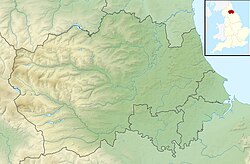| Bollihope, Pikestone, Eggleston and Woodland Fells | |
|---|---|
| Location | MAGiC MaP |
| Nearest town | Stanhope, County Durham |
| Coordinates | 54°39′56″N1°59′35″W / 54.66556°N 1.99306°W |
| Area | 7,949.19 ha (30.6920 sq mi) |
| Established | 1996 |
| Governing body | Natural England |
| Website | Bollihope, Pikestone, Eggleston and Woodland Fells SSSI |
Bollihope, Pikestone, Eggleston and Woodland Fells is a Site of Special Scientific Interest in County Durham, England. It covers a broad expanse of moorland to the north and east of Middleton-in-Teesdale.
The site has a diverse mix of habitats, mainly dry heath, with wet heath and blanket-mire in areas that are poorly drained. [1]
The SSSI, which is situated within the North Pennines Area of Outstanding Natural Beauty, shares a common boundary with the Upper Teesdale SSSI to the west, and adjoins Hamsterley Forest on three sides.
The area supports breeding populations of a number of species of birds that are listed in the United Kingdom's Red Data Book (Birds), including three— merlin, Eurasian golden plover and short-eared owl —that are listed in Annex 1 of the European Commission's Birds Directive as requiring special protection. The flora of the area includes a number of species that are scarce locally or nationally. [1]
